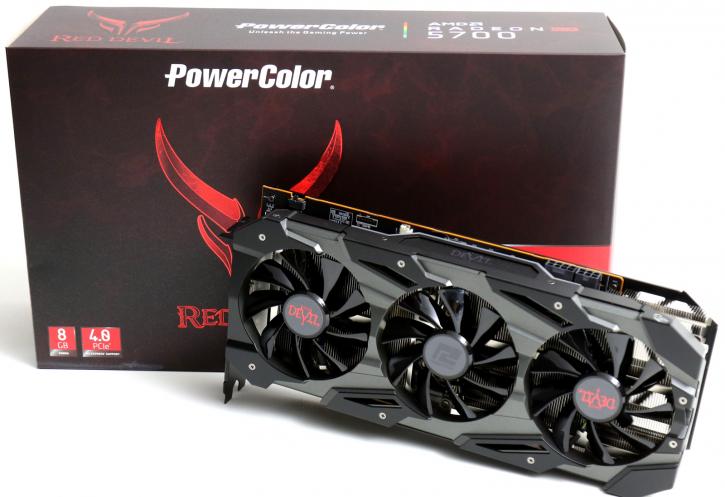Introduction
Red Devil RX 5700 8GB GDDR6
A date with the Devil
Check the beast, the PowerColor 5700 RED DEVIL (non-XT) that we review today. It has increased clocks, increased looks and well is just customized all the way. Not just that, it is marketed at a retail price of $389,-
It has been quite a journey for AMD, but it is the year 2019 and the chip producing industry is ready with their new silicon wafer fabrication at 7nm. AMD hasn't been wasting any time, Ryzen 3000 at 7nm, Radeon VII at 7nm, and today we bring you a review of both the Radeon 5700 and 5700 XT. The basis of the product that we test today is the NAVI GPU, with a die fabbed at a 7nm fabricated package and 8GB of GDDR6 graphics memory these cards are released in an aim to compete with the GeForce RTX 2060 and 2070, will it be capable to do that? We can already tell you that the numbers will be interesting to see. The most important aspect, however, is pricing. AMD wanted to tackle two price points for NAVI, for the familiar frame of mind let's call the Radeon RX 5700 the PRO revision and then the Radeon RX 5700 XT GPU versions. So the new Radeon RX 5700 and 5700 XT will cost 349 and 399 USD respectively. As we all know NAVI is the new family of mainstream to high-end (but not enthusiast) Radeon GPUs. NAVI is based on what AMD refers to as RDNA architecture (Radeon DNA). The Radeon 5700 series will also be the first commercial consumer graphics card that is PCIe Express 4.0 compatible. AMD today will launch the reference products, the AIB card with custom designs and cooling will follow in the weeks to come. Reference first though, Radeon 5700 is a GPU with 2304 stream processors. The GPU game clock is dynamic at 1.6 GHz with a peak boost clock to 1.7 GHz. It's bigger brother is the Radeon RX 5700 XT, with a fully enabled NAVI chip it has 2560 shader processors active. Its average game clock will hover in the 1.75 GHz but can boost to 1.9 GHz. We do wish AMD would not make a distinction between a game and max boost clock though as it is just too confusing for the majority of consumers. Both NAVI cards are fitted with GDDR6 memory, that means HBM2 is no longer used opposed to what you have been seeing with Vega 56/64, a clever choice as HBM2 memory is difficult to assemble onto the die substrate (lot's of yield issues there) and that makes it very expensive, next to being an expensive memory type to purchase. What AMD did well is that they have opted that 8GB GDDR6 graphics memory to run at 14 Gbps, which is nice and fast graphics memory at just the right volume size.
PowerColor 5700 RED DEVIL
Today we look at the Red Devil from PowerColor. This triple-slot cooled higher-end graphics card series will allow you to play your games in both the Full HD 1080P range as well as gaming in WQHD (2560x1440) range. The board is fed by two power connectors (6/8) and shows a surprise or two. It has a dual-BIOS mode that lets you switch between Quiet and Performance BIOS profiles, the perf mode allows for a 190W power target and the silent more at 170W. The board has 10 Phase VRM design and overclock headroom, 300W versus a 220W for the reference design. The new cooler features 2x 100mm two ball bearing fans with 5 heat pipes across a high density heatsink with copper base. As you might notice the PCB is shorter than the cooler, 240mm for the PCB and 300mm for the cooler, there’s a reasoning for that, besides more dissipation area, by having the PCB shorter than the cooler you increase the efficiency as it improves the natural flow as the hot air doesn’t get trapped according to PowerColor that is. The card runs a factory game clock frequency of 1905 MHz, making the product faster than the reference edition cards. Though the GDDR6 memory has been not been tweaked, the ICs are stock 14 GHz (effective clock-rate) but can be bumped upward towards 15 and maybe even 16 GHz. The card offers one HDMI 2.0b ports and three DisplayPorts v1.4. Embedded as well as a LED lighting system. We'll start with a product overview in the photo-shoot, but have a quick peek first after which we then head onwards into the review.


